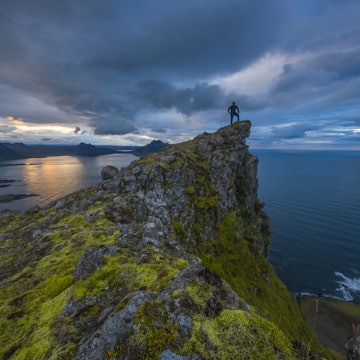

Get to know the sounds of Iceland with this guide to homegrown music © Santiago Felipe / Getty Images
Iceland blows away concerns. Its small population isn't worried about isolation or continuous winter darkness, instead focusing on its glowing passion for music and all things cultural.
From its earliest high-action medieval sagas, which were recited aloud, to the present day where many Icelanders play in a band, the country produces a disproportionate number of world-class musicians in all manner of styles. Their creativity and influences – like the grand landscape, Rekyjavík life and capricious weather – blend with the literature and sounds of yore.
Here's what you need to know about Iceland's music history, various styles and influences, and what's hot on the Icelandic music scene today.
Unique singing styles dominated through the Middle Ages
Until rock and roll arrived in the 20th century, Iceland was a land practically devoid of musical instruments and singing was the sole form of music.
The most famous song styles were rímur – poetry or stories from the sagas performed in a low, eerie chant (Sigur Rós have dabbled with the form) – and fimmundasöngur, which were sung by two people in harmony. Cut off from other influences, the Icelandic singing style barely changed from the 14th century to the 20th century. It also managed to retain harmonies that were banned by the church across the rest of Europe for being the work of the devil.
You'll find choirs around Iceland performing traditional music, and various compilation albums, such as Inspired by Harpa – The Traditional Songs of Iceland (2013), give a sample of Icelandic folk songs or rímur.
Early lyrics were influenced by Eddic and skaldic poetic styles
Lyric writing goes back to the earliest days of Icelandic life. The first settlers brought their oral poetic tradition with them from other parts of Scandinavia, and the words of the poems were later committed to parchment in the 12th century.
Eddic poems were composed in free, variable meters with a structure very similar to that of early Germanic poetry. Probably the most well known is the gnomic Hávamál, which extols the virtues of the common life – its wise proverbs on how to be a good guest are still quoted today.
Skaldic poems were composed by skalds (Norwegian court poets) and are mainly praise-poems of Scandinavian kings, with lots of description packed into tightly structured lines. As well as having fiercely rigid alliteration, syllable counts and stresses, Skaldic poetry is made more complex by kennings, a kind of compact word riddle. Blood, for instance, is "wound dew," while an arm might be described as a "hawk’s perch."
The most renowned skald was saga anti-hero Egil Skallagrímsson. In 948, after being captured and sentenced to death, Egil composed the ode Höfuðlausn (Head Ransom) for his captor Eirík Blood-Axe. Flattered, the monarch released Egil unharmed.
Instruments were not common in Iceland until the 20th century
The Vikings brought the fiðla and the langspil – both a kind of zither where a two-stringed box rests on the player’s knee and is played with a bow. Never solo instruments, they served to accompany singers. In the 19th century, harmonicas and accordions arrived, but mostly, instruments were an unheard-of luxury until the 20th century. You can see some of the push-and-pull of international influence in the film Djöflaeyjan (Devil’s Island; 1996), which depicts the lives of Icelandic families inhabiting the US military barracks left in Keflavík after WWII.
Iceland's first international hits came in the late '80s
By most measures, the first modern-era internationally famous Icelandic musicians were the Sugarcubes. They received worldwide acclaim with their album Life's Too Good (1988) which included the hit single, "Birthday." They were also part of the influential Reykjavík indie label, Bad Taste (Smekkleysa), which still champions Icelandic musicians, artists, poets and writers, and was an early grounds for fostering Icelandic creative artists. You can visit its shop at Hjartatorg and Hverfisgata 32 in Reykjavík.

Björk's contemporary songs have historic Icelandic roots
When The Sugarcubes disbanded in 1992, lead vocalist, Björk, spun off into a smashing solo career spanning a fecund range of styles from her platinum album Debut (1993) to her most recent, Fossora (2022). You’ll hear historic roots, in her song from Fossora, "Sorrowful Soil," which is influenced by a 17th-century elegiac Icelandic hymn. Check out her bestselling Gling Gló, a collection of jazz standards and traditional Icelandic songs.
Iceland's songwriters often work in other creative arts too
Björk is a force, not only as a singer, songwriter and record producer, but also as an actor and for her daring fashion collaborations and eclectic style and persona. She is an early example of how many Icelandic musicians and visual artists are serious creative artists in multiple disciplines. Another who is making a splash overseas is Ragnar Kjartansson, who is part painter, actor, director and musician. Reykjavík Art Museum's Hafnarhús and the Reykjavík art galleries and collectives do a superb job showcasing these kinds of creatives, as does the annual Reykjavík Arts Festival, held in late May or early June.

The vocals of Sigur Rós use traditional Icelandic sounds
The wildly creative band Sigur Rós have followed Björk to international stardom. Their album Ágætis Byrjun (A Good Beginning; 1999) brought them worldwide attention for lead singer Jónsi’s unique vocals (usually sung in Icelandic or an improvised vocalization they dub "Volenska") and the band’s bowed guitar techniques. Their biggest-selling album Takk… (Thanks… ; 2005) garnered rave reviews around the world and firmly cemented them on the international stage.
Seek out their concert film Heima (Home; 2007), a must-see for its blend of brilliant music and Icelandic settings captured during a series of free concerts they gave around the country upon returning from their 2006 concert tour.
One of their albums, Route One (2017), was assembled from music created while the band drove the entire Ring Road in midsummer 2016. And, in 2023 they toured internationally with a full orchestra behind their latest album Átta (Eight; 2023), featuring a singing style reminiscent of early Icelandic devotional music.
Lead singer Jónsi also had success with his joyful solo album Go (2010), and the music of Sigur Rós is used widely in film and television. It’s emblematic of the international reach of Icelandic composers in general, like Hildur Guðnadóttir, who won an Academy Award for her score to Joker (2019) and has collaborated with all manner of rock, metal and classical musicians. For example, she used to record with Icelandic band múm, making experimental electronica mixed with traditional instruments (try their album Smilewound from 2013).

Icelandic indie-folk stars have been huge international successes
Understandably, with its rich folk music history, indie-folk bands hit well in Iceland. Of Monsters and Men stormed the US charts as well in 2011 with their debut album, My Head Is an Animal. The track "Little Talks" from that album reached number one on the Billboard US Alternative Songs chart. Beneath the Skin (2015) debuted at number three on the US Billboard 200 and their latest albums are Fever Dream (2019) and EP Tíu (2022).
KALEO, a popular blues-folk-rock band from Mosfellsbær, hit the international stage with a splash – the song "No Good" from their 2016 studio album A/B garnered a Grammy Award nomination and the album peaked at 16 on the US Billboard 200. Their latest release is Surface Sounds (2021).
Singer-songwriter Ásgeir Trausti, who records simply as Ásgeir, had a breakout hit with In the Silence (2014), sung mostly in moody English, and sells out concerts internationally. His latest albums are Afterglow (2017), Bury the Moon / Sátt (2020) and Time on My Hands (2022).
Seabear, an indie-folk band, has spawned several top music-makers like Sin Fang (try Flowers from 2013) and Sóley (We Sink from 2012). Árstíðir records minimalist indie-folk and had a 2013 YouTube viral hit when they sang a 13th-century Icelandic hymn a cappella in a train station in Germany.
Today Reykjavík has a diverse and lively music scene
Reykjavík's flourishing music scene rocks with a constantly changing lineup of new bands and sounds – see Iceland Music for a sampling and check Grapevine for music news and performances. If your trip coincides with one of the country's many music festivals, go! Fabulous Iceland Airwaves (held in Reykjavík in November) showcases local and international acts. Aldrei fór ég Suður shakes up Ísafjörður every Easter, while the Þjóðhátíð (National Festival) in Vestmannaeyjar, attracts over 16,000 people for four days of music and debauchery in late July or early August.
Iceland and electronica go hand in hand, as demonstrated by Mosfellsbær-born and Grammy-nominated Ólafur Arnalds. GusGus, a top pop-electronica act has 11 studio albums while Kiasmos is an Icelandic-Faroese duo that mixes moody, minimalist electronica – check out Kiasmos (2014) or EPs like the excellent Blurred (2017).
In September 2016, Sturla Atlas, the Icelandic hip-hop/R&B phenomenon opened for Justin Bieber (whose video I’ll Show You was shot in Iceland). Other well-known Icelandic rappers include pioneering Quarashi, Gisli Pálmi, rap collective Reykjavíkurdætur (Daughters of Reykjavík), Cyber and Emmsjé Gauti.
Vestmannaeyjar Islands–born Júníus Meyvant's 2016 debut, Floating Harmonies, is a creative blend of beautifully orchestrated folk, funk and soul.
Other local acts include FM Belfast (an electronica band who set up their own recording label to release their first album, How to Make Friends; their latest is Island Broadcast); Hafdís Huld (spiky female popstress); pop-rockers BSÍ; and theremin-playing Hekla (check out Xiuxiuejar), among many others.
And you can't forget idiosyncratic pop-meister and Eurovision star Daði Freyr who rocketed to stardom with his 2020 "Think About Things" and whose videos are a Dadaesque study in humor.
















